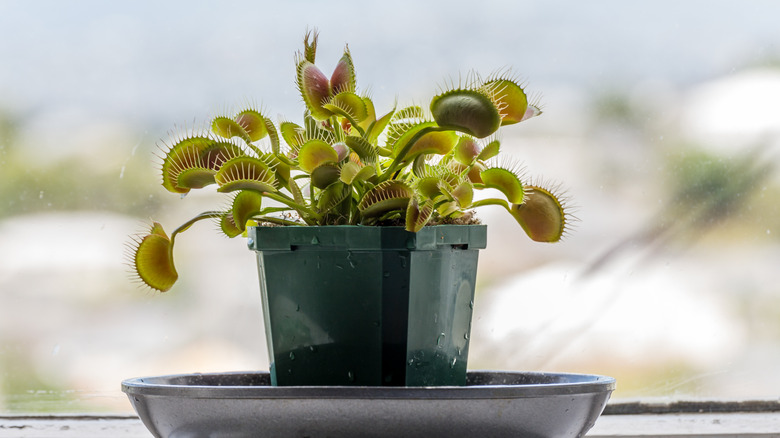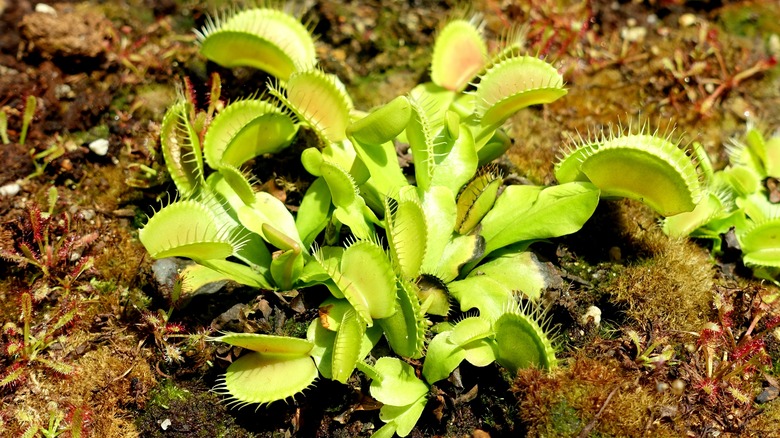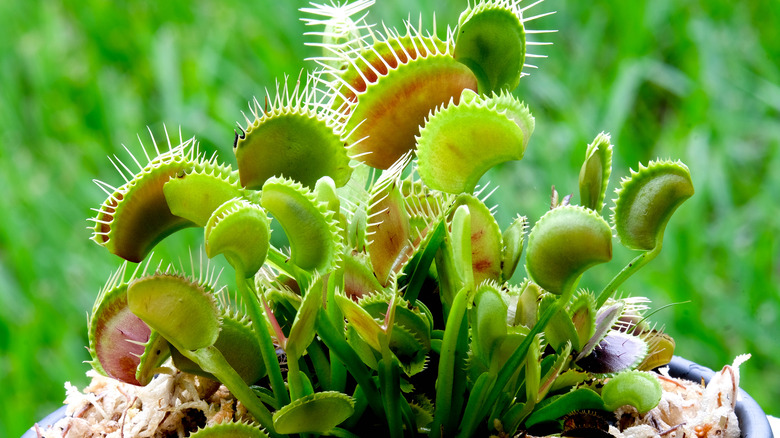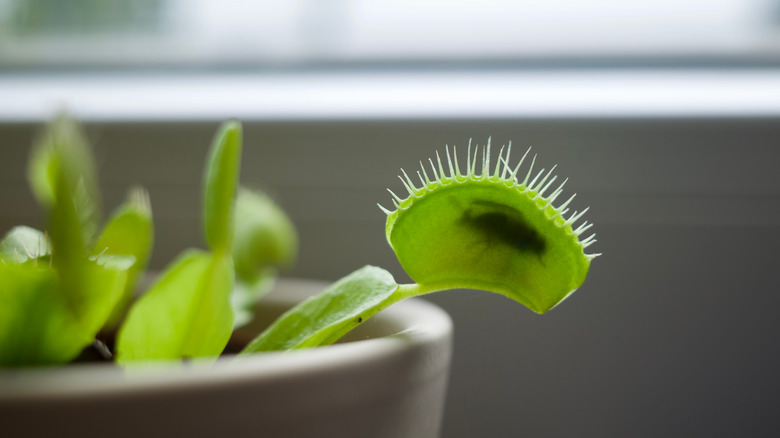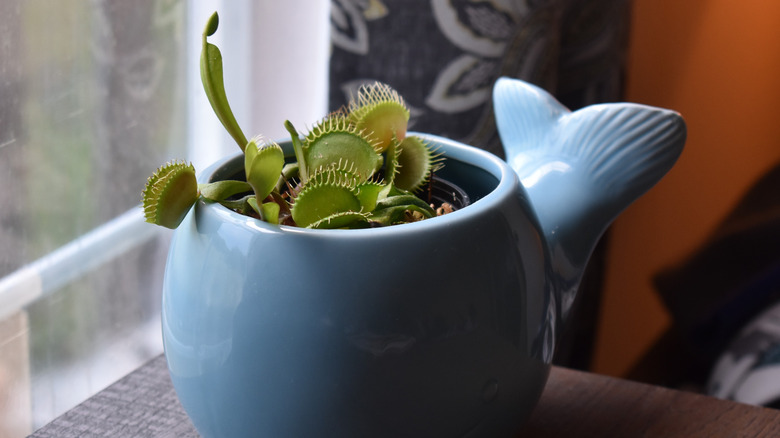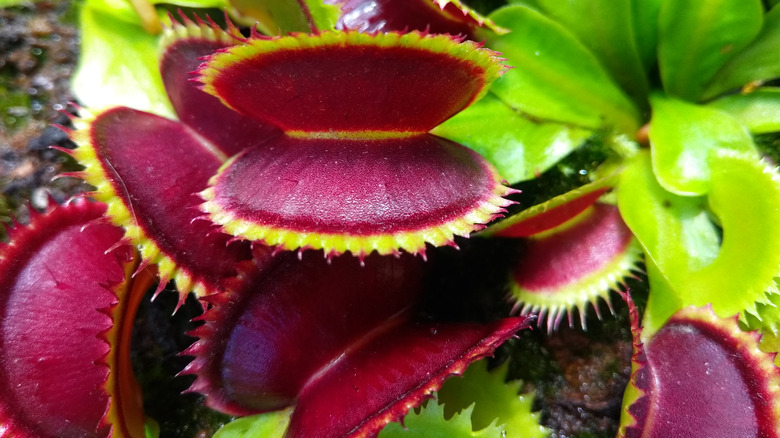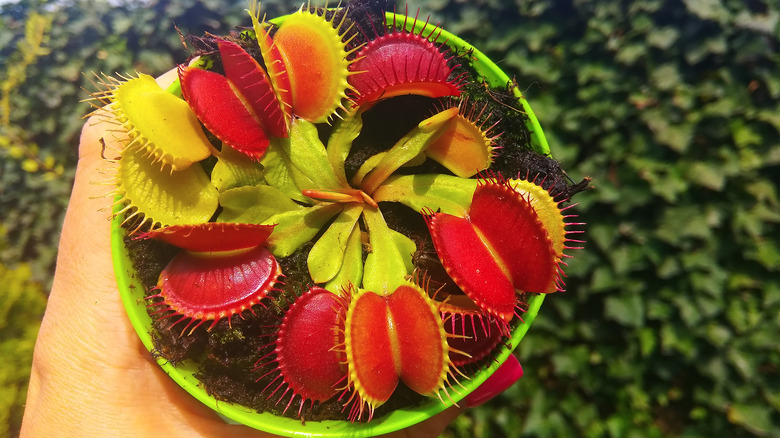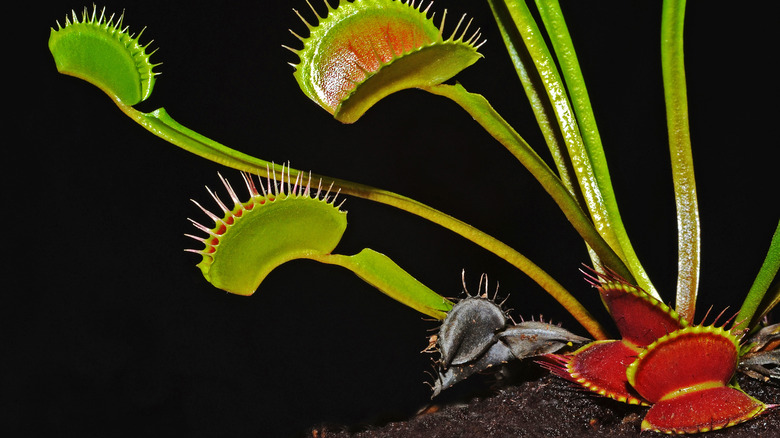How To Grow And Care For Venus Flytrap
If you like growing interesting houseplants, then a Venus flytrap (Dionaea muscipula) might be just what you need. These plants are unique because they eat bugs — primarily flies and ants. Venus flytraps look unusual: They have two greenish lobes lined with tiny hairs called trichomes that catch their prey. The pink insides of the lobes release a sweet nectar that attracts insects. When a fly or other critter lands between the lobes, they will snap quickly around it. The National Wildlife Association explains that tiny teeth line the outer edges of the lobes to prevent any insects from escaping. It takes a large amount of energy to close the traps, so they will only close if they sense two movements in about 20 seconds, according to LiveScience.
While other carnivorous plants exist, the Venus flytrap is one of only a few that literally move to catch prey. The Great Outdoors Nursery explains that they don't generally catch big bugs because most plants don't get very large. An average plant grows about 5 to 6 inches in diameter, with each trap growing about 1 to 1.5 inches long. Regardless of their size, watching one in action is fascinating.
How to use Venus flytraps in garden
Venus flytraps are native to the southeast U.S., and they can grow in a flower garden, but the conditions must be right. According to Fine Gardening, they thrive in swampy areas with lots of indirect light and moist, sandy soil. If your garden does not meet these conditions, growing your plant outside in a pot might be the better option. Since the plants are relatively small, you don't need a large pot — just make sure it can drain water because this flow is essential to keep the plant's roots healthy and happy. Put the pot in a place that gets at least six hours of indirect sunlight. Remember to water it because just one or two days of dry soil can do a lot of damage.
Bring your Venus flytrap inside for the winter and put it in a dark room that won't get below freezing. You will still need to water it, just less often — about once every three to four weeks should be fine.
How to grow Venus flytrap
You can propagate your Venus flytrap fairly easily. The stalk of your plant will need to be between 2 and 4 inches tall and in need of repotting (which will give you more stalks to choose from). When removing the plant from the soil, use planting forceps to separate the stalks. The stalk you are repotting should have its own root system and rhizomes, per the International Carnivorous Plant Society. Separate the stalk and plant in the appropriate mixture of soil. Give it some water, and place it where it will get a decent amount of indirect light. Be patient because it could take some time to see the plants mature — sometimes five months.
Another way to grow Venus flytraps is to collect seeds after they flower, which happens toward the end of summer. Collect the seeds from the blooms, sprinkle them over moist soil, and lightly tap them into the dirt. Place the pot in another container of standing rainwater. Sarracenia Northwest suggests removing any mold or fungus that may attempt to grow in the pot. You should begin to see your plant grow within one to two months.
How to care for Venus flytraps
The most important thing to remember about your carnivorous friend is that it needs to catch bugs because of the nutrients they provide. If your plant is not catching bugs (which is entirely possible if you keep it indoors), then you might need to help it out. To do this, you'll need to capture a live fly or other insect with a pair of tweezers and place it in one of the plant's traps. Flies are difficult to catch, so Better Homes & Gardens recommends small spiders, caterpillars, and beetles.
According to The Spruce, dead bugs won't work because they must be moving in order to trigger the plant's feeding process. You'll also need to give it insects based on the size of its lobes — don't feed it bugs that are larger than one-third the size of the traps. Keep in mind that the trap could stay closed for as long as 10 days as it digests the bug.
Needs for the Venus flytrap
As far as light, you should find a place where your Venus flytrap will get plenty of indirect light. Direct sun – especially in the summer — can cause the plant to burn and die. In addition, keep your plant 4 to 7 inches from artificial light. When it comes to water, the best way to know if your plant needs a drink is to pay attention to how it looks. The lobes should always be slightly pink, and the stems shouldn't look too long. Keep the soil moist but not too wet. Better Homes & Gardens doesn't recommend giving the plant water from the tap because it will likely be too alkaline or have too many minerals.
These unusual plants like acidic soil that drains well. Better Homes & Gardens notes that regular potting soil should not be used but rather a mixture of two-thirds sphagnum peat moss and one-third sand. You should never fertilize Venus flytraps, nor should you add lime to the soil. Venus flytraps also like it humid, and they need to be in a part of the room that gets plenty of circulation. Gardening Know How recommends growing your Venus flytrap in a terrarium because that creates humidity.
Varieties of Venus flytrap
You can find a few varieties of Venus flytraps available on the market. Many of them have rather dramatic names emphasizing their unusual features, according to The Spruce.
- Dionaea 'Petite Dragon' is a small variety of the plant with tiny traps measuring a mere 1/2 inch across.
- Dionaea 'Ginormous' is the opposite of the petite types, with traps that can get up to larger than 2 inches across.
- Dionaea 'DC All Red' looks quite different with its bright red lobes.
- Dionaea 'Red Piranha' looks like the Red Dragon variety, but it has short, triangular-shaped teeth, according to Sarracenia.
- Dionaea 'Fused Tooth' varieties will have several teeth which look like they have grown together, per the International Carnivorous Plant Society (ICPS).
- Dionaea muscipula 'Alien' looks different from other varieties with its arched-shaped traps, according to ICPS.
- Dionaea 'Sawtooth' has uneven, jagged teeth that look similar to the edge of a sawtooth blade, per ICPS.
How to repot Venus flytraps
To keep your plant happy, it's best to repot about once a year. This keeps the soil fresh, allowing the roots room to grow. Repot during the spring or summer, and don't do it while it is flowering. Choose a plastic pot that is at least 4 inches deep to accommodate the root system, which includes white, bulbous rhizomes. The Spruce notes that a pot allowing about 2 inches on each side of the roots for proper insulation is best.
Prepare a pot with the proper soil mixture and water with filtered or rainwater. Gently squeeze the sides of the pot to loosen some of the soil. Carefully remove the plant without distributing the rhizomes or the traps. Holding by the root ball, shake excess dirt free before placing it in the prepared soil. Press the soil into place around the roots and water thoroughly. Sometimes traps will die as a result of transplanting, but this is nothing to be worried about.
Other things about Venus flytraps
It is normal for the plant's lobes to turn black and fall off, so don't be alarmed when you see this happening. Fine Gardening notes that most of them don't last all season. Venus Flytrap World points out that the only time you should be concerned about the lobes is when they don't grow back after turning black and falling off. Like other houseplants, your Venus flytrap will go dormant for part of the winter, and their lobes will die. According to Better Homes & Gardens, you should keep them in temperatures between 35 and 50 degrees Fahrenheit during the winter months and bring them back into warmer temperatures after the beginning of spring.
While you might want to stick your finger in the plant's traps, it's not a good idea. The Spruce explains that this wastes precious energy the plant needs to capture insects.
